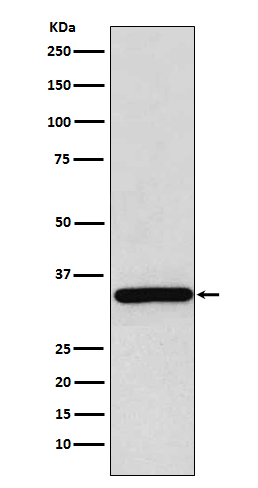

| WB | 咨询技术 | Human,Mouse,Rat |
| IF | 1/20-1/50 | Human,Mouse,Rat |
| IHC | 1/100-1/200 | Human,Mouse,Rat |
| ICC | 技术咨询 | Human,Mouse,Rat |
| FCM | 咨询技术 | Human,Mouse,Rat |
| Elisa | 咨询技术 | Human,Mouse,Rat |
| Aliases | 35DAG; DAGA4; DMDA; Gamma-sarcoglycan; LGMD2C; MAM; Sarcoglycan gamma; SCARMD2; SCG3; SGCG; TYPE;;gamma Sarcoglycan |
| WB Predicted band size | 32 kDa |
| Host/Isotype | Rabbit IgG |
| Antibody Type | Primary antibody |
| Storage | Store at 4°C short term. Aliquot and store at -20°C long term. Avoid freeze/thaw cycles. |
| Species Reactivity | Human |
| Immunogen | A synthesized peptide derived from human gamma Sarcoglycan |
| Formulation | Purified antibody in PBS with 0.05% sodium azide,0.05% BSA and 50% glycerol. |
+ +
以下是关于gamma-Sarcoglycan抗体的3篇参考文献,按文献名称、作者和摘要内容简要概括:
---
1. **文献名称**: "Mutations in the gamma-sarcoglycan gene in patients with limb-girdle muscular dystrophy"
**作者**: McNally EM, et al.
**摘要**: 该研究通过基因测序发现gamma-Sarcoglycan基因突变是肢带型肌营养不良症(LGMD 2C)的致病原因,并利用特异性抗体检测患者肌肉活检样本,证实突变导致gamma-Sarcoglycan蛋白表达完全缺失。
2. **文献名称**: "Adeno-associated virus-mediated gene therapy for sarcoglycan-deficient muscular dystrophy"
**作者**: Li J, et al.
**摘要**: 研究通过腺相关病毒(AAV)载体向gamma-Sarcoglycan缺陷小鼠模型递送正常基因,Western Blot和免疫组化结果显示治疗后肌肉组织中gamma-Sarcoglycan蛋白表达恢复,抗体检测证实功能重建。
3. **文献名称**: "Comparative analysis of sarcoglycan complex components in human skeletal muscle"
**作者**: Vainzof M, et al.
**摘要**: 通过免疫荧光和蛋白印迹技术,系统分析肌营养不良患者中Sarcoglycan复合体各亚基(包括gamma-Sarcoglycan)的表达模式,发现不同基因突变会导致复合体中其他成员(如α/β-Sarcoglycan)的继发性缺失。
---
以上文献涵盖gamma-Sarcoglycan抗体在疾病机制研究、基因治疗验证及诊断分析中的应用。如需具体期刊信息或发表年份,可进一步补充关键词检索。
The gamma-sarcoglycan antibody is a crucial tool in studying muscular dystrophies, particularly limb-girdle muscular dystrophy (LGMD). Gamma-sarcoglycan is a transmembrane protein component of the dystrophin-glycoprotein complex (DGC), which stabilizes muscle cell membranes during contraction. It forms a subcomplex with alpha-, beta-, and delta-sarcoglycans, critical for maintaining sarcolemma integrity. Mutations in the gamma-sarcoglycan gene (SGCG) disrupt this complex, leading to LGMD type 2C (LGMD2C), characterized by progressive muscle weakness and degeneration.
Gamma-sarcoglycan antibodies are widely used in research and diagnostics to detect protein expression levels, localization, and structural abnormalities in muscle biopsies. In research, these antibodies help elucidate disease mechanisms, validate animal models, and assess therapeutic interventions like gene therapy or exon-skipping approaches. Clinically, they aid in differentiating LGMD subtypes through immunohistochemistry or Western blotting, guiding personalized treatment strategies.
The development of specific monoclonal and polyclonal gamma-sarcoglycan antibodies has improved diagnostic accuracy and enabled high-throughput screening. Recent studies also explore their utility in monitoring gene therapy efficacy, as experimental treatments aim to restore functional sarcoglycan complexes. Despite advancements, challenges remain in standardizing antibody specificity across laboratories. Overall, gamma-sarcoglycan antibodies remain pivotal in advancing both the understanding and management of sarcoglycanopathies.
×